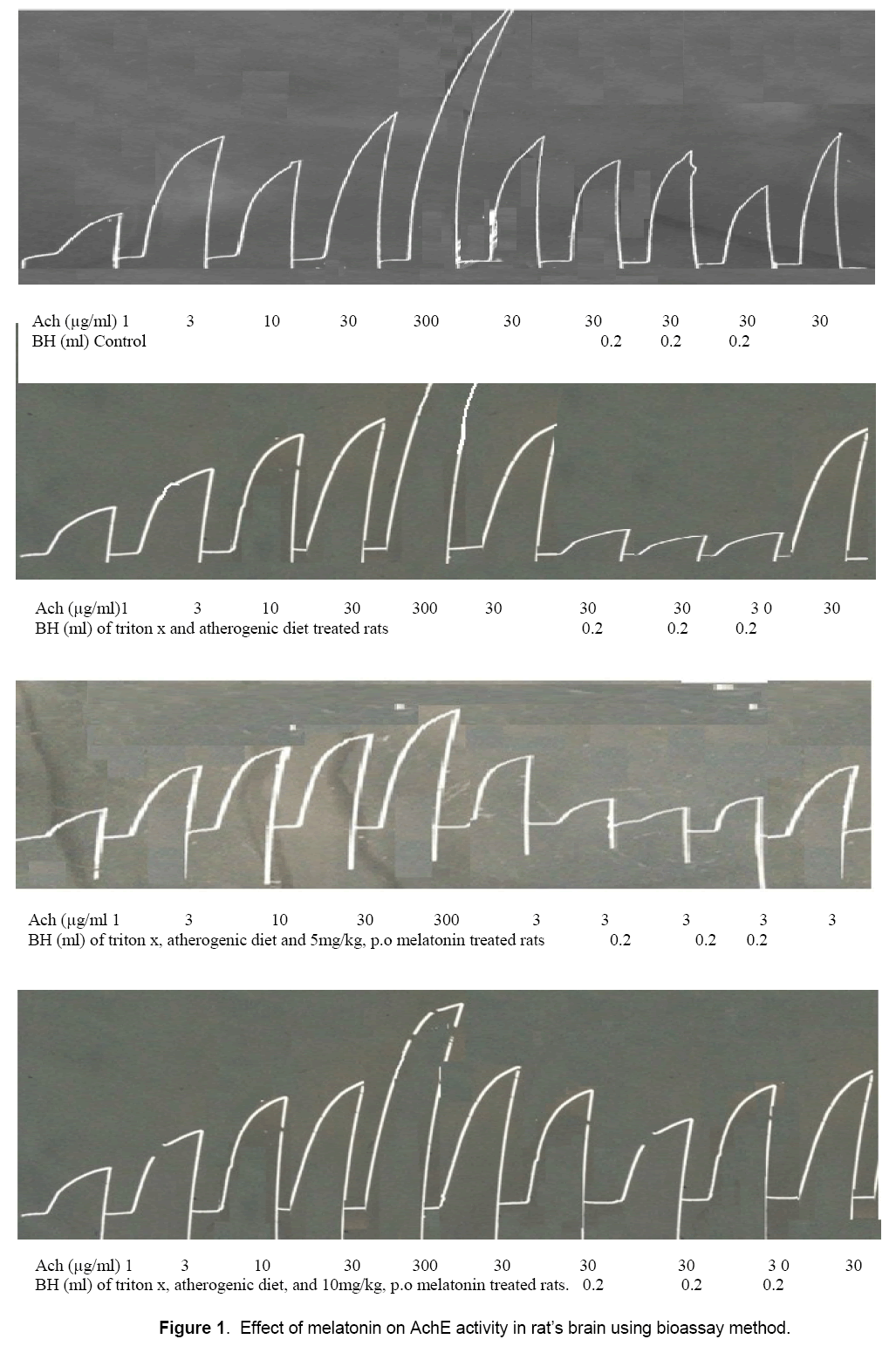Effect of Melatonin on Vascular Dementia
Repala Anusha, Akondi Butchi Raju, Donapati Deepika, Bashetty Phanindhra, Gadiyaram Vikas
Repala Anusha1,Akondi Butchi Raju2,*,Donapati Deepika1,Bashetty Phanindhra1,Gadiyaram Vikas1
1St. Peters Institute of Pharmaceutical Sciences,Vidyanagar,Hanamkonda,Warangal-506001,India
2Ibn Sina National College of Medical Studies,Jeddah,Saudi Arabia
Abstract
Vascular dementia is a common problem caused by falling of blood supply to cortex of brain due to hyperlipidemia and atherosclerosis. Melatonin, a pineal hormone was proved to be effective as antidementia and antihyperlipidemic agent previously. In the present study we evaluated the effect of melatonin (5mg/kg, 10mg/kg, p.o) on hyperlipidemia induced vascular dementia in rats. To mimic the human condition the rats were induced dementia by feeding atherogenic diet for 20days and single shot of triton x100(100mg/kg, i.p). The experiment with combined model of hyperlipedemia( Both chemical and diet induced) was taken up for the first time and able to establish successfully. Parameters like locomotar activity, radial arm maze test, morris maze and active avoidance test, biochemical estimations of total cholesterol, triglycerides, HDL, LDL, super oxide dismutase, Catalase activity, acetylcholine esterase activity and lipid peroxidation products were estimated. The melatonin (10mg/kg, p.o) significantly (P<0.05) improved hyperlipidemia and impaired cognition induced by combination of triton x and atherogenic diet by significantly reversing the levels of TC, TG, LDL, HDL levels, super oxide dismutase, catalase, AchE activity and lipid peroxidation products to normal levels when compared to induced group. Both doses of melatonin 5mg/kg, 10mg/kg showed protective effect but 10mg/kg has more prominent results when compared to5mg/kg. These results indicate that melatonin treatment successfully reduced vascular dementia via its antioxidant mechanism and inhibition of AchE in brain.
Keywords
Antidementia; Melatonin; Hyperlipidemia; Acetylcholine esterase activity; Antioxidant.
1. Introduction
Proper learning and acquisition is important function of brain. This function of brain alters or declines with increase in age and sometimes this is also accelerated by other underlying brain disorders and by falling of blood supply to brain that carries oxygen and nutrients to brain which is due to peripheral diseases such as cardiovascular disorders,hypertension,hyperlipidemia,and atherosclerosis. These results in dementia causing damage to the cortex of the brain which is the area associated with learning,memory,and language [1]. According to epidemiological studies hyperlipidemia and atherosclerosis are major risk factors for vascular dementia [2,3]. Hypercholesterolemia in rats enhances the number of working and reference memory errors,but do not find any changes in beta-amyloid and nerve growth factor levels [4]. Cholesterol does not cross BBB even though it is highly lipophillic therefore it is synthesised locally in brain and degraded to 24-hydroxy-cholesterol,which is secreted from brain into the blood stream. Cholesterol stimulates γ-secretase which results in enhanced degradation of β-amyloid which causes dementia [5].
A part from brain denovo cholesterols,serum cholesterols are also assumed to be involved in causing dementia by processing of amyloid precursor protein (APP) in lipid rafts [6,7]. Dietary fat increases serum cholesterols which reduce arterial inflow to brain that leads severe brain hypoxia [8]. Hypoxia causes brain ischemia which makes alterations in APP expression,cleavage,enhances Aβ production and declined its clearance from brain due to fall in blood supply to brain that result in dementia and finally AD [9]. Thus denovo cholesterol synthesis in brain,high serum cholesterols induced cerebro- vascular blockade and cholesterols induced oxidative stress are three possible hyperlipidemic mechanisms involved in occurrence of vascular dementia [10]. Melatonin is a pineal hormone proved to be effective as antioxidant antihyperlipidemic agent and having a property to reverse cognitive impairment [11-13]. Apart from direct free radical scavenging activity melatonin also stimulates free radical decomposition by stimulating antioxidant enzymes such as superoxide dismutase,catalase,and glutathione and augments the expression of antioxidant genes [14-17]. As melatonin has both antidementia and antihyperlipidemic properties,present research was carried out to evaluate effect of melatonin in hyperlipidemia induced vascular dementia [18-20]. To mimic the human condition of hyperlipedemia induced vascular dementia,a combined experimental model was attempted for the first time using triton X 100 and atherogenic diet. Triton X 100 increase denovo cholesterol synthesis by acting on serum lipoprotein lipase and atherogenic diet increases serum cholesterol levels [21]. These high levels of cholesterols produce reactive oxygen species (ROS) and cause oxidative stress to neuronal cells which leads to neuronal cell deterioration [22].
2. Methods
Animals: 24 Male Albino Wistar rats (150-200) were procured from Sanzyme limited,Hyderabad and maintained in an air conditioned room (25ºC) and 60% humidity with a 12hr night and day cycle. Rats were fed with normal pellet diet and water ad libitum. The rats were allowed to acclimatize to the laboratory environment for a week before the start of the experiment. All experimental procedures were conducted in conformity with committee for the Purpose of Control and Supervision of experiments on animals (CPCSEA). The research protocols were approved (03/SPIPS/IAEC/13) by Institutional Animal Ethics committee (IAEC) for the care and use of animals and were strictly followed throughout the study.
Drugs and chemicals:
Triton x-100 was obtained from SD fine chemicals,Mumbai. Test drug melatonin,total cholesterol and triglyceride kits were obtained from Aristo Pharmaceuticals Pvt Limited.
Induction of hyperlipidemia:
The rats were given single intraperitoneal injection of freshly prepared solution of Triton X-100(100 mg/kg) in physiological saline solution and fed with atherogenic diet after overnight fasting for 18 hrs. After 72 hrs of injection two of induced groups were treated with test drug.
Grouping and treatment:
Four groups of animals were used,each group consisting of six rats.
Group 1: Normal control rats received only vehicle.
Group 2: Rats received triton x 100 (100mg/kg,i.p) and atherogenic diet for 20 days (Combined hyperlipidemia model)
Group 3: Rats received low dose of melatonin (5mg/kg,p.o) against triton combined hyperlipidemia model and dementia
Group 4: Rats received high dose of melatonin (10mg/kg,p.o) against combined hyperlipidemia model and dementia
The animals were trained for maze task performance by conducting daily training trial during which they did not receive any drug. The completely trained animals were chosen for the study. These animals were induced with triton X- 100 and atherogenic diet. After confirmation of induction of hyperlipidemia by lipids estimation and dementia by radial arm maze two groups of induced animals were dosed once in a day with the melatonin and fed with atherogenic diet for 20 days along with daily training trial. Reference and working memory errors using radial arm maze,locomotar activity,bodyweight and TC,TG,HDL,LDL levels were estimated on 6th,12th and 20th days after melatonin treatment.Estimation of locomotar activity:
Estimation of locomotar activity:
Locomotar activity of animals was evaluated using actophotometer which helps to evaluate locomotar activity of animals that indicates alterations in body weight of animals.Equipment was turned on and rats were placed individually in the square arena for 10min and numbers of counts were noted. Basal activity of all the animals was noted on the 0th day. After induction on 3rd day and after treatment on 6th,12th,20th day locomotar activity of all rats was measured according to standard methods [23].
Behavioural methods:
Radial arm maze:
A Radial arm maze was used to evaluate working memory in the animals. After 1hr of the treatment with melatonin to respective groups all the rats on 6th,12th,20th days were tested for working and reference memory errors [24].
Morris maze method:
All the animals are subjected to 5 days training in the designed apparatus and on the final day of experiment the latency period for identification of platform by all rats were measured [25].
Active avoidance test:
Active avoidance test helps to evaluate the associative learning of the animal and the test was conducted in Medicraft jumping box. Prior to avoidance training,each rat was habituated to the apparatus for 2 min. Transfer time from one compartment to another,number of avoidances and escape response are recorded. On the final day number of avoidances were noted [26].
Biochemical estimation of lipids:
Serum total cholesterol [27],triglycerides [28],LDL,HDL [29] levels and atherogenic index [30] of all animals were estimated by collecting blood through retro orbital sinus puncture under mild ether anaesthesia on 0th,3rd day after induction,and 6th,12th,and 20th days after melatonin treatment to test groups using standard protocol methods.
Biochemical estimation of antioxidant parameters:
Superoxide dismutase activity:
The enzyme activity of superoxide dismutase (SOD) was determined in brain homogenate using photo-oxidation method. The change in optical density was measured at 460nm for 4 minutes using spectrophotometer [30].
Catalase activity:
The enzyme activity of catalase was determined in brain homogenate based hydrogen peroxide oxidation method of luck et al. The absorbance of hydrogen peroxide solution can be easily measured at 240 nm,using spectrophotometer. On decomposition of hydrogen peroxide by catalase,the absorbance decreases with time [31].
Lipid peroxidation:
The amount of lipid peroxidation products present in the homogenate samples of brain was estimated by the thiobarbituric acid reactive substances (TBARS) method of Ohkawaka,et al,which measures the malonaldehyde (MDA) reactive products by using UV-Visible spectroscopy at 532nm [32].
Acetylcholine esterase activity estimation:
AchE activities were measured using Elman’s method and bioassay method of Manasa et al. In Elman’s method artificial substrate acetyl thiocholine was used and released thiocholine upon AchE action is reacted with DTNB(5,5’-dithiobis- (2- nitro benzoic acid) which is reduced to thionitrobenzoic acid a yellow colored anion with an absorption maximum at 412 nm using spectrophotometer. Change in absorbance per min. was calculated [33]. In bioassay
method Frogs rectus abdominus muscle was dissected and mounted in organ bath with ringers solution.DRC was taken using Ach stock(1mg/ml).AchE(brain homogenate) and Ach sub maximal dose was incubated for 15 min and responses were recorded which indicates AchE activity of brain homogenate [34].
Statistical analysis:
All experimental groups were composed by 6 animals. The results were presented as the mean ± SEM. Statistical analysis was done by ANOVA followed by Bonferroni’s tests using Graph pad PRISM software version 6. P< 0.05 was considered as statistically significant.
3. Results
Effect of melatonin on locomotar activity: The experimentally induced atherogenesis significantly (P<0.05) limits the movement of rats when they were tested for locomotar activity. This observation is very significant and confirms the weight gain. Up on melatonin (5mg/kg &10mg/kg,p.o) treatment rats showed significant (P<0.05) reversal in locomotar activity this may be due to reduction in lipid levels (Table 1).

Effect of melatonin on behavioural models Radial arm maze: The triton X and atherogenic diet induced cognitive impairment significantly increased the number of reference memory errors (RME) and working memory errors (WME) when they were tested for reference and working memory using radial arm maze. Melatonin (5mg/kg & 10mg/kg,p.o) treatment showed the protective effect against induced cognitive impairment by limiting number of reference memory and working memory errors (Table 2 and 3). Until the last day of experiment RME and WME of induced group of rats were significantly raised from 2.6±0.21to 3.0±0.36 and 2.5±0.67to 2.8±0.40 respectively.RME and WME were significantly (P<0.05) reversed in melatonin (10mg/kg,p.o) treated rats from 2.6±0.21to 0.66±0.21and 2.6±0.33to 0.5±0.22 respectively (Table 2,3.)
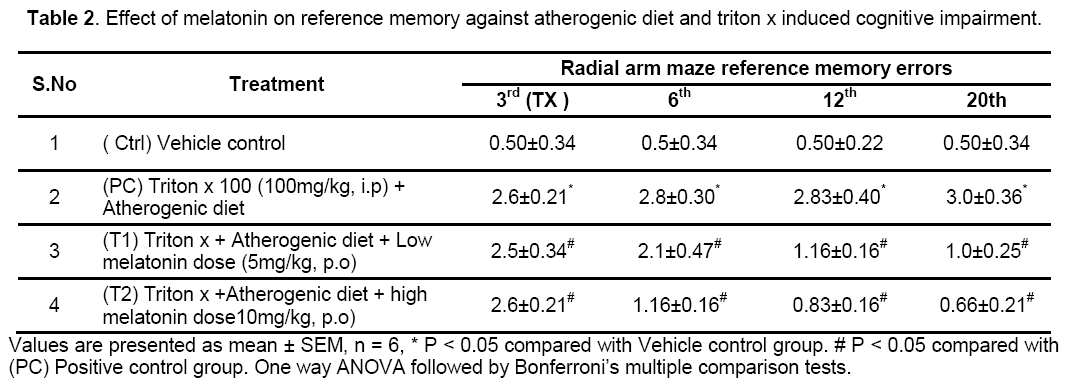
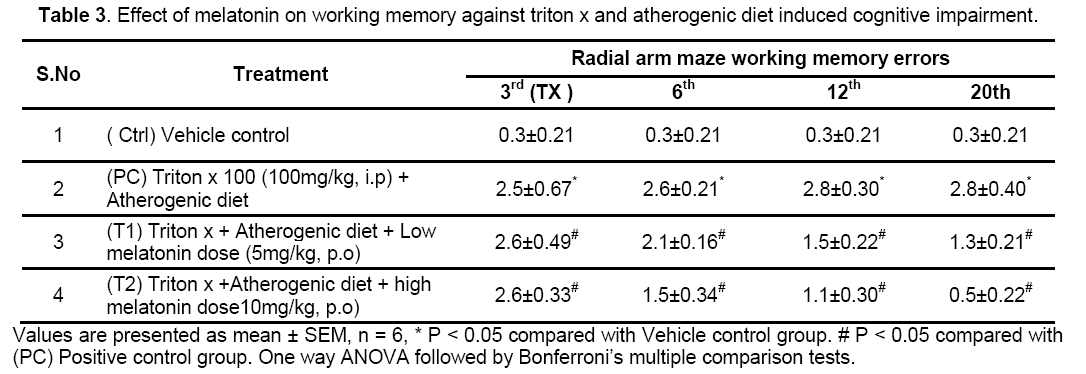
Morris maze method: The triton x and atherogenic diet induced cognitive impairment significantly increased the latency period for identification of hidden platform when they were tested for spatial memory using morris water maze. Melatonin (5mg/kg & 10mg/kg,p.o) treatment showed the protective effect against induced cognitive impairment by limiting the latency period for hidden platform identification. Melatonin (10mg/kg,p.o) treatment significantly (P<0.05) reversed the latency period for platform identification from 102.5±2.5to 70.8±1.53 (Table 4).
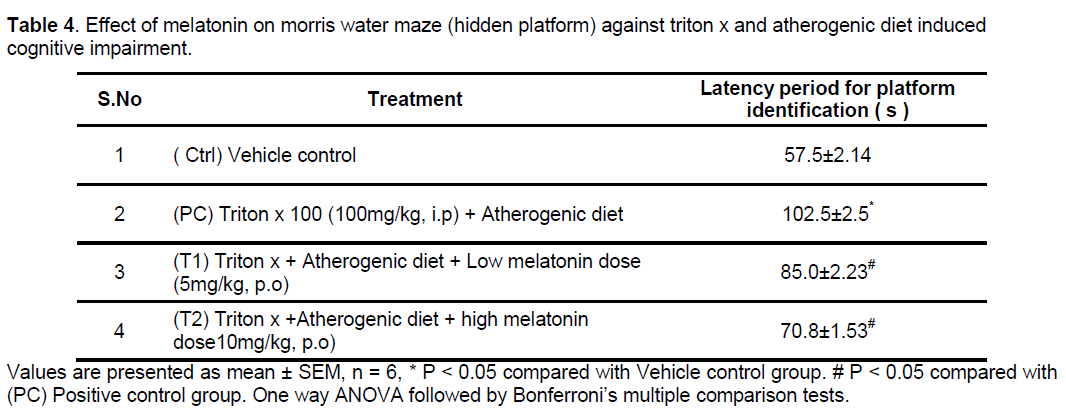
Active avoidance test: The triton x and atherogenic diet induced cognitive impairment limits the number of avoidances when rats tested for alertness using active avoidance paradigm. This observation is very significant and confirms the cognitive impairment. Melatonin (5mg/kg & 10mg/kg,p.o) treatment showed the protective effect against induced cognitive impairment by increasing the number of avoidances. Melatonin (10mg/kg,p.o) treatment significantly (P<0001) reversed the reduced avoidances from 6.1±0.30 to 9.6±0.2 (Table 5).

Effect of melatonin on serum lipid profile Triglycerides (TG): The experimentally induced atherogenesis significantly increased the triglyceride levels in blood when compared to normal control group. This observation is very significant and confirms hyperlipidemia. This increase in TG may be due to the effect of triton x on denovo lipid synthesis and high fat intake induced LDL synthesis increases in the liver. The fat consists of TG as its major constituent and the LDL helps in the transportation of TG from the dietary food to the blood and to the tissues and the circulation of TG in the blood increases. Melatonin (5mg/kg & 10mg/kg) treatment significantly (P< 0.05) reversed the increased TG levels (Table 6).
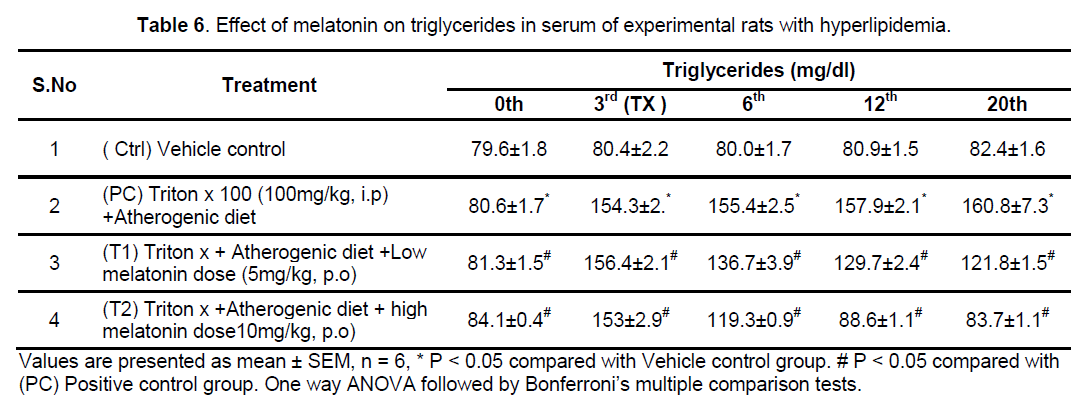
Total cholesterol: The experimentally induced atherogenesis significantly increased the total cholesterol levels in blood when compared to normal control group. This observation is very significant and confirms hyperlipidemia. Melatonin (10mg/kg,p.o) significantly (P<0.05) reversed the increased total cholesterol levels in serum from 199.2±6.8 to 53.9±2.8 when compared to induced group. This observation indicates protective effect of melatonin against hypercholesterolemia (Table 7).
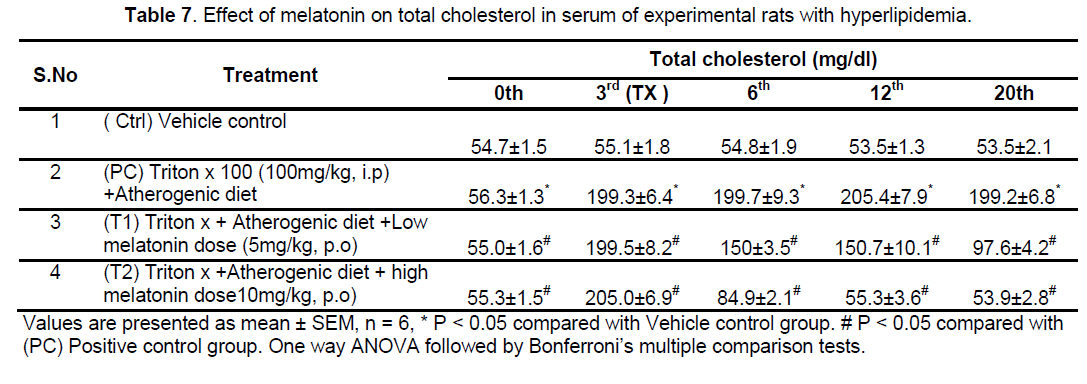
Lipoproteins (HDL and LDL): The experimentally induced atherogenesis significantly decreased the high density lipoprotein levels in blood and increased the low density lipoproteins when compared to normal control group. Generally the liver synthesis LDL and it helps in the transportation of TG and TC to the required tissues in order to produce energy. When the high fat diet and triton x is taken the liver synthesis more amount of LDL in order to transport more amount of TG and TC which is consumed from the diet. HDL synthesis will be decreased by liver. Melatonin (5mg/kg & 10mg/kg,p.o) treatment significantly (P< 0.05) reversed the increased levels of HDL and LDL(Table 8,9).
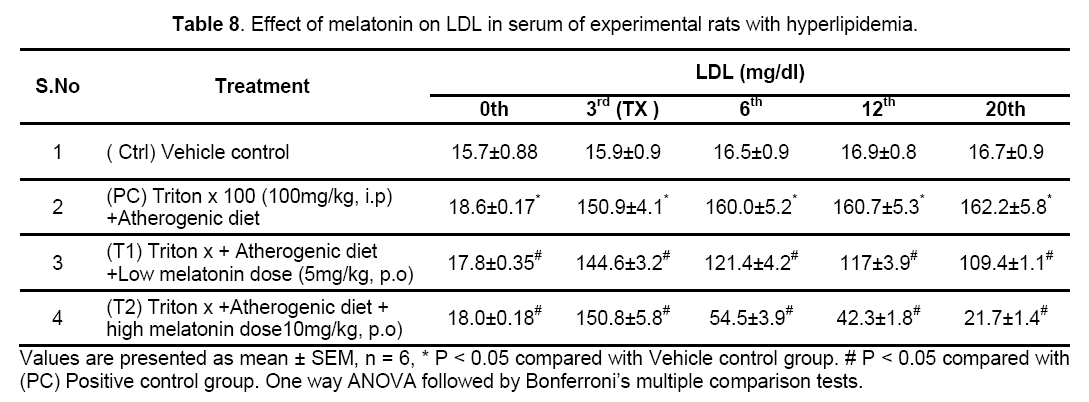
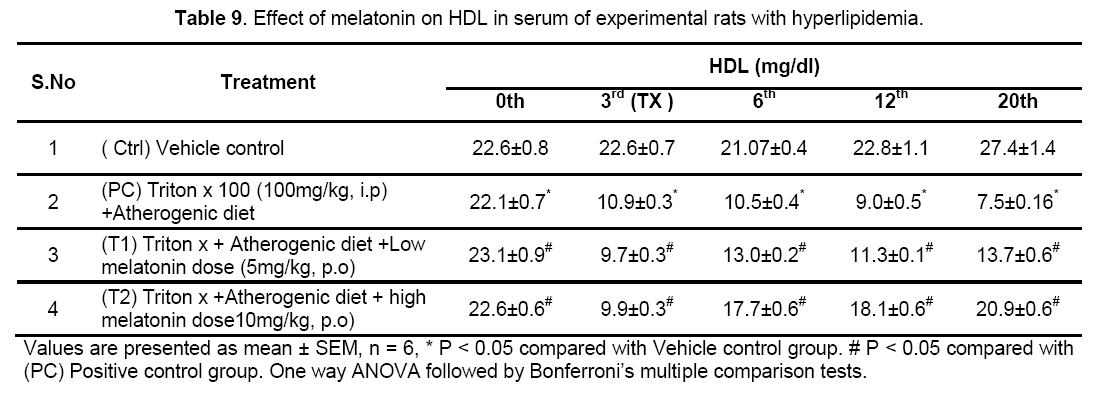
Atherogenic index: The experimentally induced atherogenesis significantly (P< 0.05) increased the atherogenic index values when compared with control group. This observation is very significant and confirms atherogenesis. Melatonin (10mg/kg,p.o) treatment had significantly reversed the increased atherogenic index values from 19.5±0.09 to 1.93±0.10. This observation indicates protective effect of melatonin (5mg/kg & 10mg/kg,p.o) on atherosclerosis (Table 10).

Effect of melatonin on oxidative stress: Melatonin (5mg/kg & 10mg/kg,p.o) treatment significantly prevented loss of enzyme activity and prevented raise in brain MDA levels when compared to induced group. In SOD activity estimation SOD levels were decreased in induced group from 66.9±2.3 to 29.3±1.4. High dose melatonin treatment significantly (P<0.05) reversed SOD scavenging activity significantly to 59.6±1.0 when compared to induced group. In Catalase activity estimation %H2O2 scavenging activity was decreased in induced group from 65.7±4.78to 37.7±0.70. High dose melatonin treatment significantly (P<0.001) reversed catalase activity to 60.5±3.53 when compared to induced group. In lipid peroxidation (LPO) estimation,brain malondialdehyde levels which are secondary products of lipid peroxidation were increased from 22.9±1.19 to 46.1±1.74. High dose melatonin treatment showed significant (P< 0.05) protective effect by declining peroxidation products to 26.0±0.75.Thus melatonin showed protective effect against triton x and atherogenic diet induced cognitive impairment by maintaining the antioxidant enzymes activity and preventing increase in MDA levels (Table 11).
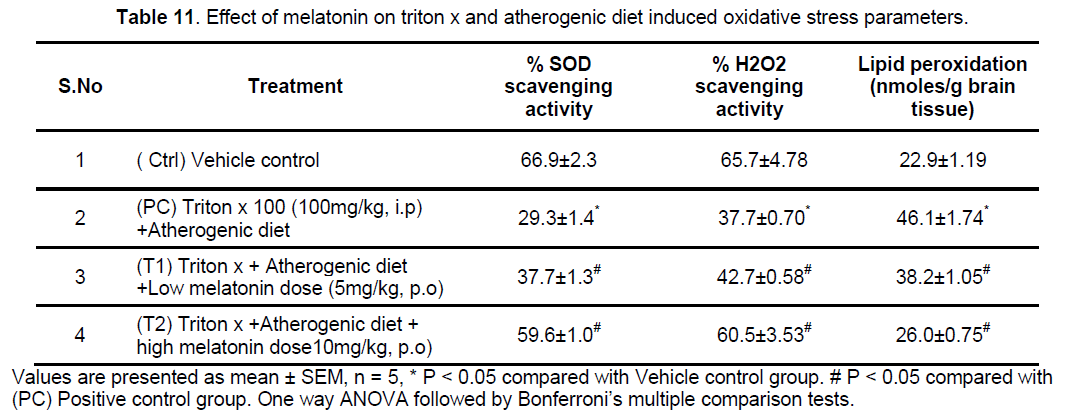
Effect of melatonin on acetylcholine esterase: In the present study the triton X and atherogenic diet induced cognitive impairment significantly elevated brain acetyl cholinesterase activity from 120.0±1.87 to 214.0±3.15 when estimated using Elman’s method. Melatonin treatment significantly (P<0.0001) reversed the elevated acetyl cholinesterase activity to 121.7±1.60 when compared with induced group. AchE activity also measured by bioassay method using frogs rectus abdominus muscle. Decrease in Ach responses were observed when known concentrations of Ach was added to brain homegentae of rats which indicates presence of AchE in BH’s. In the induced rats brain homogenate added bioassay the responses of acetylcholine were found to be significantly declined where as in the melatonin (5mg/kg and 10mg/kg,p.o) treated rats brain homogenate added bioassay there is a reversal of acetylcholine responses in dose dependent manner due to cholinergic effect of melatonin (Table 12,Figure 1).

4. Discussion
Dementia is a brain disorder where the patients are manifested with loss of memory. It is contributed by many other underlying brain disorders as well as by other such as hypertension,hyperlipidemia,atherosclerosis,and stroke. Hyperlipidemia induced cognitive impairment has been reported in previous studies [35]. Increased cholesterols cause cognitive impairment by decrease in cholinergic neurons and by inducing BBB leakage which leads to influx of peripheral toxins in to brain. In the present research triton X 100 and atherogenic diet were used for the first time to induce hyperlipidemia and cognitive impairment. This experimental model is suitable and mimics human condition effectively [9].
Triton x 100 a surfactant increases denovo synthesis of lipids in the liver and other parts of body where cholesterol synthesis occurs by some unknown action on lipoprotein lipase enzyme. It also cause brain cholesterol synthesis as brain required cholesterols cannot be obtained from periphery. Atherogenic diet has high fat contents such as TG,which are transported from dietary food to blood by LDL. Because of this process of transportation,liver synthesise LDL continuously and transport to blood which results in high serum lipid profile.
Melatonin is a hormone which secret from pineal gland and plays an important role to maintaining circadian rhythm in the body. It is used therapeutically in jet log,insomnia associated with old age. Recently it was proved to be effective in reducing cholesterol levels and improving memory impairment in rats. These two effects were attributed to its powerful antioxidant activity. When compared to trolox,vitamin C,GSH,mannitol,melatonin was proved to be effective as antioxidant [7]. Melatonin a part from its direct radical scavenging activity,it also enhances other antioxidant enzymes by its direct genomic action which results in increased antioxidants gene expression and the same mode of stimulating effect was observed in the present study which was understood by increased SOD,catalase activity [36,37]. Based on the above facts,the melatonin was evaluated for its effect against a new combined model of hyperlipidemia induced dementia in rats [38]. After treatment with melatonin (5mg/kg & 10mg/kg,p.o),cholesterols levels are decreased treated rats when compared to triton X and atherogenic diet fed rats. Locomotar activity of rats was declined upon induction and it was gradually and significantly reversed in melatonin high dose treated group of rats.
Rats were tested for their memory acquisition by using behavioural models such as radial arm maze and morris maze method. Radial arm maze performance is an appetitive motivated task which is useful to assess the spatial reference as well as spatial working memory performance Hyperlipidemia Induced group of rats had showed more number of reference and working memory errors. Melatonin treatment had reversed reference memory,working memory errors of rats when compared with induced control.
Morris maze method also used for spatial memory examination. Latency period was long in induced group of rats for identification of hidden platform which was significantly less in melatonin high dose treated rats. Another behavioural test,active avoidance method was also performed which indicates the alertness of the rats for various stimulations such as light,sound,and electricity and avoiding from these stimulations. Induced rats showed less number of avoidances when compared to control and melatonin treated rats showed significant decrease in less number of avoidances.
Many clinical and preclinical studies report oxidative stress as one of the Pathophysiology associated with AD and dementia. Benett et al. and Peizhong demonstrates that mitochondrial dysfunction occurred because of some unknown aetiology produce reactive oxygen species which damage the cell components of the cell like DNA,RNA,proteins and lipids. This cell death results in synapse damage and cause further neuronal cell degeneration which finally results in manifestation of dementia. Therefore oxidative parameters were also estimated. Antioxidant enzyme levels and lipid peroxidation levels in melatonin high dose treated rats were brought to normal levels when compared to triton x and atherogenic diet treated rats. The triton X and atherogenic diet induced cognitive impairment significantly reduced the antioxidant enzyme activity of SOD and catalase. This observation is very significant and confirms deficiency in antioxidant defensive system which was one of the causes for dementia. Melatonin treatment significantly prevented loss of activity of these antioxidant enzymes when compared to induced group. Triton X and atherogenic diet induced cognitive impairment significantly increased the brain malondialdehyde (MDA) levels compared to control group. MDA is a secondary product of lipid peroxidation. Melatonin treatment significantly prevented the rise in brain MDA levels compared to induced group. An acetylcholine esterase activity was measured using Elman’s method and bioassay on FRAM using brain homogenate. In both the methods AchE activity was significantly increased and Ach concentration was decreased in induced group. This restored Ach responses indicates cholinergic effect of melatonin. Thus based up on the results,induction by triton X and atherogenic diet had showed significant changes in physical,biochemical,behavioural parameters. Melatonin treatment restored all abnormal changes to normal and showed protective effect against atherogenic cognitive impairment. This effect may be attributed to melatonin’s anti-oxidant and anti-acetylcholine esterase activity.
5. Discussion
The present research indicates protective effect of melatonin against triton X 100 and atherogenic diet induced hyperlipidemia and cognitive impairment in rats. Melatonin exerts this significant protective effect by antioxidant mechanism and inhibitory action on acetylcholine esterase.
References
- Celine U,Michael P,Christain H (2010) Hypercholesterolemia in rats impairs the cholinergic system and leads to memory deficits. Mol Cell Neurosci. 45: 408-417.
- Humpel C (2010) Chronic mild cerebrovascular dysfunction as a cause for AD?. Experimental Gerontology. 46: 225-232.
- Carmia B (2006) Garlic Reduces Dementia and Heart Disease Risk. J Nutr.136: 810-812.
- Christian C,Mirjam M,Szymon K,Kurt K,Roland S,Peter O (2005) High Sensitivity of Human Melatonin,Alertness,Thermoregulation,and Heart Rate to Short Wavelength Light. J Clin Endocrino Metab. 90: 1311-1316.
- Rebeck GW (2004) Cholesterol efflux as a critical component of Alzheimers disease. J Mol Neurosci. 23: 219-224
- Jose LG,Teresa RM,Elisa P,Piergiorgio M,Robert B,Gianuigi F (2000) Cholesterol decreases secretion of the secreted form of amyloid precursor protein by interfering with glycosylation in the protein secretory pathway. Biochem. J. 348: 307-313.
- Thomas J,Nelson,Daniel L,Alkon (2005) Oxidation Of cholesterol by Amyliod precursor protein and β-amyliodpeptide. J Biol Chem. 280: 7377-7387.
- Ehrlich D,Humpel C (2012) Chronic vascular risk factors (cholesterol,homocysteine,ethanol) impair spatial memory,decline cholinergic neurons and induce blood-brain barrier leakage in rats in vivo. J Neurol Sci. 322: 92-95.
- Puglielli L,Rudolph E,Kovacs MD (2013) Alzheimer’s disease: Cholesterol connection. Nat Neurosci. 6: 345-351.
- Srinivasan V,Pandi-Perumal SR,Cardinali DP,Poeggeler B Hardeland R (2006) Melatonin in Alzheimer's disease and other neurodegenerative disorders. Behav Brain Funct. 2: 1-23.
- Mozaffari S,Ranjbar S,Abdollahi M (2012) The mechanism of positive effects of melatonin in dyslipedemia. A systematic review of animal and human studies. Int.J .Pharmcol. 8: 496-509.
- Srinivasan VR (1999) Melatonin,Oxidative stress and ageing. Current Science. 76: 46-54.
- Mansfield J,Garfinkel D,Lipson S (2000) Melatonin for treatment of sundowning in elderly persons with dementia a prelimnary study. Arch. Gerontol. Geriatr. 31: 65-76.
- Anusha R,Rakesh A,Bhavani M ,Phanindra B,Deepika D,Mahesh R.(2013) Melatonin ,Biosynthesis and its various effects. Journal of pharmacy. 1: 05-09.
- Luchetti F,Canonico B,Betti M,Arcangeletti M,Pilolli F,Piroddi M (2010) Melatonin signalling and cell protection function. The FASEB J. 24: 3603-3624.
- Gooley JJ,Chamberlin K,Smith KS,Khalsa SS,Shantha M,Elizavanree(2011) Exposure of room light before bed time suppresses melatonin duration in humans. J Clin Endocrinol Metab. 96: 463-472.
- El-Missiry.M.A,Othman.A.I,Alabdan.M.A (2011) Melatonin for protection against ionising radiation. In: Dr. Mitsuru neon; editor. Current topics in ionising radiation research. Chapter 21: 443-468.
- Rodrigo P,Carlos B (2011) Structural neuroplasticity induced by melatonin in entorhinal neurons of rats exposed to toluene inhalation. Acta Neuobiol Exp. 71: 541-547.
- Vale.M.I,Andreottis.S,Barnabeperes.S,Forato.A.G,Boreges-Silva.C.n,Neto.J.C (2005)Melatonin enhances leptin expression by rat adipocytes in presence of insulin. AM J Physiol Endocrinol Metab. 288: 805-812.
- Sodipo O A,Abdularahman F I,Sandabe U K(2012) Total cholesterol,faecal cholesterol,Very low density lipoprotein cholesterol (VLDL-C),Atherogenic index (A.I),and percent atherosclerosis with aqueous Fruit Extract of Solanum macrocarpum in chronic Triton- induced hyperlipidemic albino rats,J. Bio. Sci. 4: 206-214.
- Arun A,Kumar T,Balakrishna P,Sadasivan K. (2004) hypolipidemic effect of coriander sativum L. in triton-induced hyperlipidemic rats. Indian J Exp Biol. 42: 909-912.
- Yoshikazu.Y,AL-Suhiko.H,Kazuyoshi.T,Masako.O,Bunpei.I(2010) Effects of melatonin: basic studies and clinical applications. J Antiaging Med. 7: 85-91.
- Kulkarni SK.(2005) Hand book of Experimental Pharmacology. 3rd ed. Vallabhprakashan. pp. 168-169.
- Russell WB,Karen SB,Jay Frye GD.(2002) Mecamylamine blocks enhancement of reference memory but not working memory produced by post-training injection of nicotine in rats tested on the radial arm maze. Behavioural Brain Research. 134: 259-265.
- Alikatte KL,Akondi BR,Yerragunta VG,Veerareddy PR,PalleS (2012) Antiamnesic activity of Syzygiumcumini against scopolamine induced spatial memory impairments in rats. Brain Dev. 34: 844-851.
- Trinder P (1969)Estimation of glucose in blood. Ann. Clin. Biochem. 6: 24.
- Bucolo G,David H(1973) Quantitative determination of serum triglycerides by the use of enzymes. Clin Chem. 19: 476-482.
- Allain CC (1974) Diagnostic reagent for quantitative in vitro determination of Cholesterol in human serum. Clin Chem. 20: 470.
- Altan O,Gunay C,Hasan K,Gulay H (2010) “Atherogenic index of plasma” (log10 triglyceride/high-density lipoprotein?cholesterol) predicts high blood pressure,diabetes,and vascular events. J Clin Lipidol. 4: 89- 98.
- Arutla S,Arra GS,Prabhakar CM,Krishna DR(1998) Pro- and Anti-Oxidant Effects of Some Antileprotic Drugs in Vitro and Their influence On Super Oxide Dismutase Activity. Arzneim.-Forsch J Drug Res. 48: 1024.
- Luck H and Bergmeyer HU(1971) Catalase in Methods of Enzymatic Analysis. Ed.,Academic Press,Newyork,NY,USA. pp. 885-893.
- Okhawa H,Ohishi N,Yagi K(1979) Assay for lipid peroxides in animal tissues by thiobarbituric acid reaction. Ann Biochem. 95: 351-358.
- Ellman GL. Tissue sulfhydryl groups (1959) Arch Biochem Biophys. 82: 70-77.
- Manasa S,Sharada V,Raju A B (2013) Assay for screening of acetyl cholinesterase inhibitors. Int. J. Chem. Sci. 11: 197-200.
- Marzia P,Allan D (2012) Oxidative stress and down syndrome: A route toward Alzheimer’s like dementia. Curr Gerontol Geriatr Res. 2012: 1-10.
- Konturek SJ,Konturek PC,Brozozowski.T,Bubenik.G.A.(2007) Role of melatonin in upper gastrointestinal tract. J Physiol Pharmcol. 58: 23-52.
- Korkamaz A,Reiter R,Topal T,Manchester L C,Oter S,Tan D.(2009) Melatonin: An established antioxidant worthy of use in clinical trials. Mol Med.15: 43-50.
- Danielle K L,Shameena B,Farida S.(2010) A high cholesterol diet elevates hippocampal cytokine expression in an age and estrogen dependant manner in female rats. J Neuro Immunol. 223: 31-38.

Open Access Journals
- Aquaculture & Veterinary Science
- Chemistry & Chemical Sciences
- Clinical Sciences
- Engineering
- General Science
- Genetics & Molecular Biology
- Health Care & Nursing
- Immunology & Microbiology
- Materials Science
- Mathematics & Physics
- Medical Sciences
- Neurology & Psychiatry
- Oncology & Cancer Science
- Pharmaceutical Sciences
